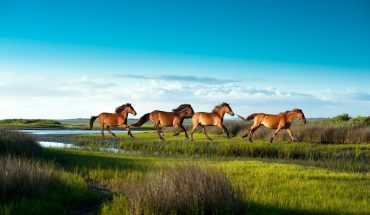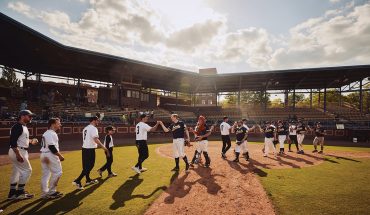text and illustrations by Frank Harmon
The Dorton Arena at the N.C. State Fairgrounds was a technological wonder when it was built in 1952. Its cable-supported roof spanned the length of a football field and comfortably housed 7,600 spectators under a roof only three inches thick. Designed by Matthew Nowicki (1910-1950), then acting Director of Architecture at N.C. State University’s School of Design, it was the first major cable-supported building in the world. It helped make North Carolina an example of the new progressive South.
It also kept me out of jail.
As a student traveling in the Rift Valley of Jordan near Israel, I had stopped to make camp and was brewing a cup of tea when over the hill came two trucks full of soldiers in the Jordanian Army, weapons ready. They thought I was a spy. The lieutenant, who spoke English, asked me where I was from. When I said, “I’m a student of architecture, and I’m from North Carolina,” he said, “Raleigh, North Carolina? So you know the Dorton Arena?” I couldn’t have been more surprised if he had pulled out a cello and started playing. Because army officers are trained as engineers, his engineering textbook had described the Dorton Arena. In fact, the Dorton Arena is probably North Carolina’s best-known building around the world. I offered him a cup of tea.
Nowicki, a gifted architect who immigrated to the United States from Poland, designed the structure as an open-air livestock-judging pavilion. His client was State Fair manager J.S. Dorton, who wanted to make the N.C. State Fair the most modern in the world. As legislators got more interested in the dynamic structure, they provided money to enclose and condition the building. Norwicki died in a plane crash before it was finished, so William Henly Deitrich, a respected Raleigh architect, completed it. Fred Severud from New York, who later designed the structure for the Gateway Arch in St. Louis, was the structural engineer.
The structure is made of two 400-foot-long concrete parabolic arches, tilted and crossing near the ground. Steel cables, made by the same company that built the Brooklyn Bridge, tie the arches together underground. A grid of cables was strung across the tops of the arches to form the roof membrane. Imagine a giant “Pringle” 300 feet long, and you’ve got the picture.
Like other innovative projects, the Dorton Arena had its challenges. Two years after it was completed, Hurricane Hazel slammed into its roof with 100-mph winds, causing the fabric roof to flutter alarmingly. To solve this problem, engineer Severud designed a system of cables and shock absorbers that tie the roof down like an immense cobweb.
Acoustics were a problem, too. The curved roof and hard surfaces created echoes of several seconds’ duration. To remedy the ricocheting sound, acousticians hung flag-sized sound absorbent panels from the cables. One politician wanted the acoustic panels to be Confederate flags. Thankfully, he was ignored.
Arenas were originally built in ancient Rome as places for spectacle, from circuses to gladiatorial combat, and the name is derived from the Latin word for a fine sand that was used to absorb blood spilled on their floors. The greatest Roman arena was the Colosseum in Rome, which could seat 80,000 spectators in A.D. 70 and was covered by a fabric roof stretched on ropes. Almost 2,000 years later, North Carolinans erected their own fabric-draped arena.
Like many landmarks, the Dorton Arena has its share of urban legends. For example, a highway patrolman supposedly escorted a contractor to the fairgrounds one night in 1950 so that he could dig a hole before the Korean War stopped all construction. A night watchman at the fairgrounds told one of my favorites: “Do you know why this building looks so strange?” he asked, looking me in the eye. “It’s because when they unrolled the plans, they was all in Polish!”
For more than 60 years the Dorton Arena has sheltered rock concerts, ice hockey, roller derbies, wrestling, political rallies, boat shows, and the circus. A circus seemed especially appropriate there: The trapeze, the safety net, the lines supporting the gymnasts’ mast, the crack of the whip all seemed at home in this building, itself made of tightly stretched cables.
On a Sunday afternoon in the 1980s, I went with my children to see Ringling Brothers Barnum and Bailey Circus. From our seats we could see the sun shining on cumulus clouds and trees swaying in the wind. In the arena 14-year-old girls were doing flips on the backs of ponies racing in circles while a parade of lions, elephants, giraffes, clowns, and gymnasts on motorcycles snaked through the space from the west doors. The blast of the human cannonball rattled the windows, horns barked, and the ringmaster cracked his whip like the sound of doom. Outside we could see Hillsborough Street connecting waffle houses and churches and the everyday journey from home to work. Inside we saw magic.
But as magical as a circus performance could be, few circus riggers liked the Dorton Arena. “There’s no place to tie off to,” one of them told me. “No place to hang the trapeze.” It was inconvenient. A small observation here: Sometimes magic is more important than convenience.
To this day, cresting the hill at Blue Ridge Road north of the fairgrounds, I am thrilled to see the arena’s great arc tilted against the horizon. Once on a cold rainy night, I caught a glimpse of the inside from Hillsborough Street, the roof lifted like the ruffled dress of a flamenco dancer lit by footlights. On fireworks night at the State Fair, you see bombs burst over its roof, the pungent smell of gunpowder mingling with fried turkey legs and cotton candy.
Buildings keep us dry and warm and allow us to work, eat, and love. Occasionally they give us joy. While some remember the Dorton Arena as the venue where Jimi Hendrix and Led Zeppelin played, others think of it is as a big room that must be cleaned. I see it as a place for the spirit, bathed in sunlight on an autumn afternoon, sparrows chirping in the dust, the roof creaking like a sailboat at sea. More like a cathedral than a cowshed.
And it could keep a young man out of trouble. A lot of trouble.






